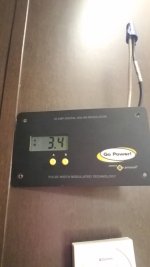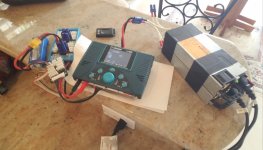My toyhauler came with a 155watt panel, 30amp GoPower pwm controller and they ran 10awg wire to the batteries that are roughly 20 feet away as the mouse flies.
At first i thought i would simply add another panel or 2 in parallel and run thicker wire. Get close to the solar controllers max rating of 500watts.
I briefly read about mix matched panels. To my surprise the one article i read was saying its better to run them in series. Even better approach is to use multiple solar controllers if you have different panels.
Now im wondering if its best to leave the current setup alone. Then add new panels and a new controller. Negative to that is added costs. Was hoping to get 500watts as cheap as possible. I would like to buy quality wire though so i can upgrade to even more solar down the road.
I tested my panel years ago and remember it being somewhere in the 18v range. Not at the trailer to test it again. I was reading that will be a big factor in trying to decide what additional panels to buy.
Ive been thinking about using a separate starting battery for my genny. So if i did have 2 solar controllers i could use my smaller 155watt panel to keep my genny starting battery topped off. Problem for me is waking up in glamis with very low batteries. Sun isnt producing solar yet. I hate putting that big generator load on the depleted pair of 6volts. I have older spare 12v starting/hybrid marine batteries that would be great to use for the genny only. I could then deplete my 6volts a little more than youre supposed to at night.
........................................................
So the main questions are:
1. Any cool online stores that have quality wire for decent prices?
2. Do i need to know my exact solar panel voltage before people can help advise on additional panels to buy or what approach will be most efficient? (just remember im a cheapo trying to get to 500watt for now.......once my 6volts die i will go to lithium batteries, big inverter and more solar.....so im kind of hoping whatever panel i buy now will also work down the road)

At first i thought i would simply add another panel or 2 in parallel and run thicker wire. Get close to the solar controllers max rating of 500watts.
I briefly read about mix matched panels. To my surprise the one article i read was saying its better to run them in series. Even better approach is to use multiple solar controllers if you have different panels.
Now im wondering if its best to leave the current setup alone. Then add new panels and a new controller. Negative to that is added costs. Was hoping to get 500watts as cheap as possible. I would like to buy quality wire though so i can upgrade to even more solar down the road.
I tested my panel years ago and remember it being somewhere in the 18v range. Not at the trailer to test it again. I was reading that will be a big factor in trying to decide what additional panels to buy.
Ive been thinking about using a separate starting battery for my genny. So if i did have 2 solar controllers i could use my smaller 155watt panel to keep my genny starting battery topped off. Problem for me is waking up in glamis with very low batteries. Sun isnt producing solar yet. I hate putting that big generator load on the depleted pair of 6volts. I have older spare 12v starting/hybrid marine batteries that would be great to use for the genny only. I could then deplete my 6volts a little more than youre supposed to at night.
........................................................
So the main questions are:
1. Any cool online stores that have quality wire for decent prices?
2. Do i need to know my exact solar panel voltage before people can help advise on additional panels to buy or what approach will be most efficient? (just remember im a cheapo trying to get to 500watt for now.......once my 6volts die i will go to lithium batteries, big inverter and more solar.....so im kind of hoping whatever panel i buy now will also work down the road)



